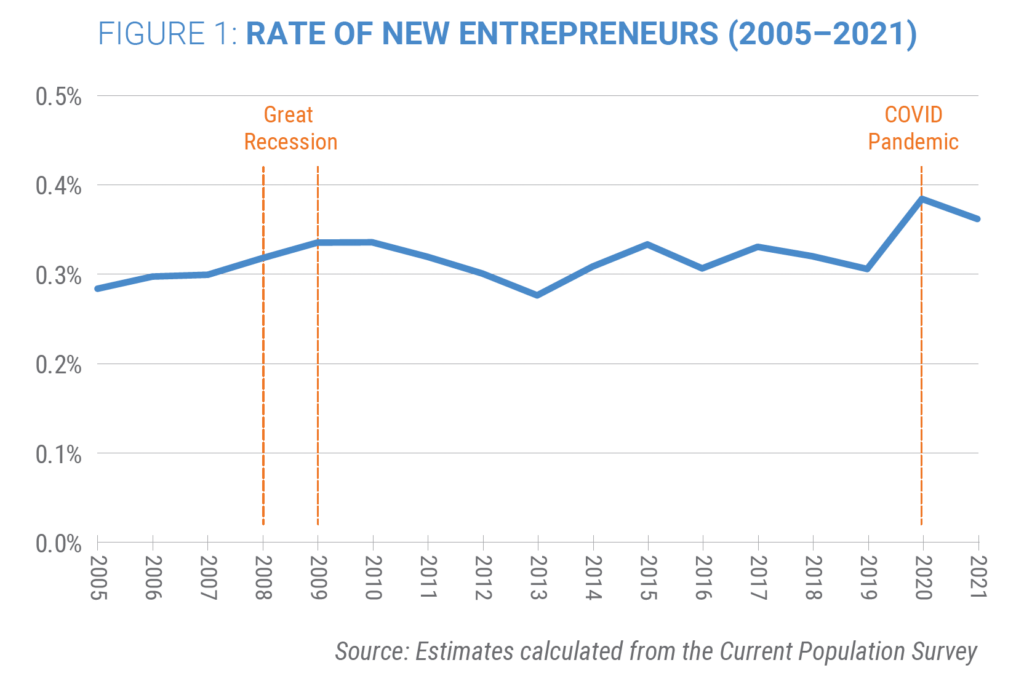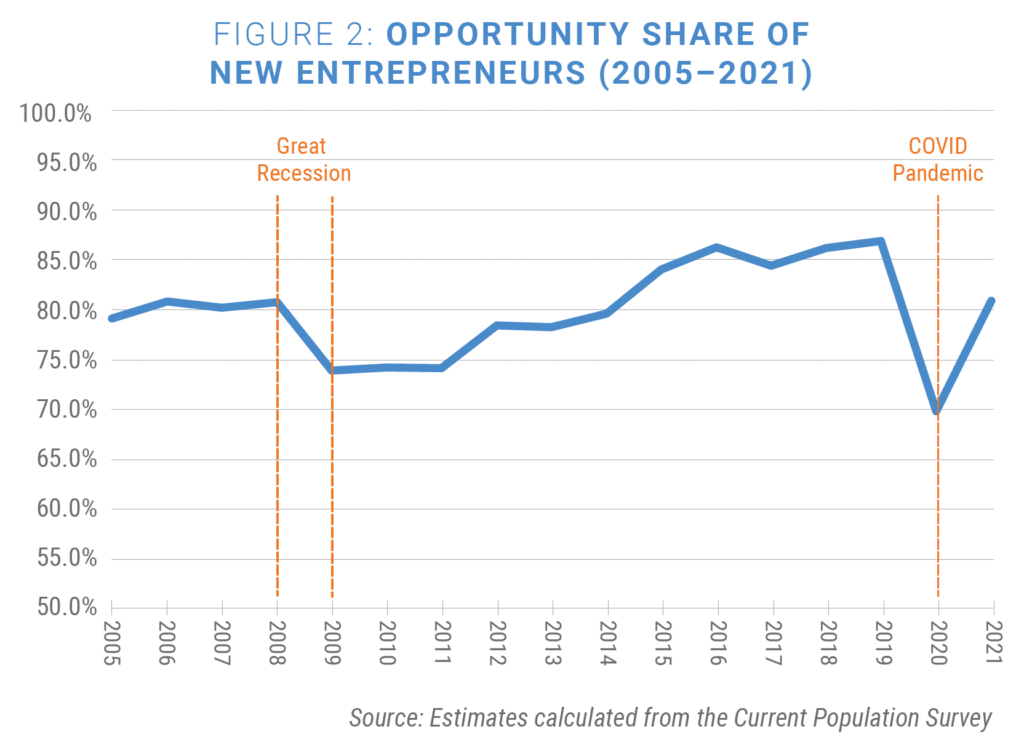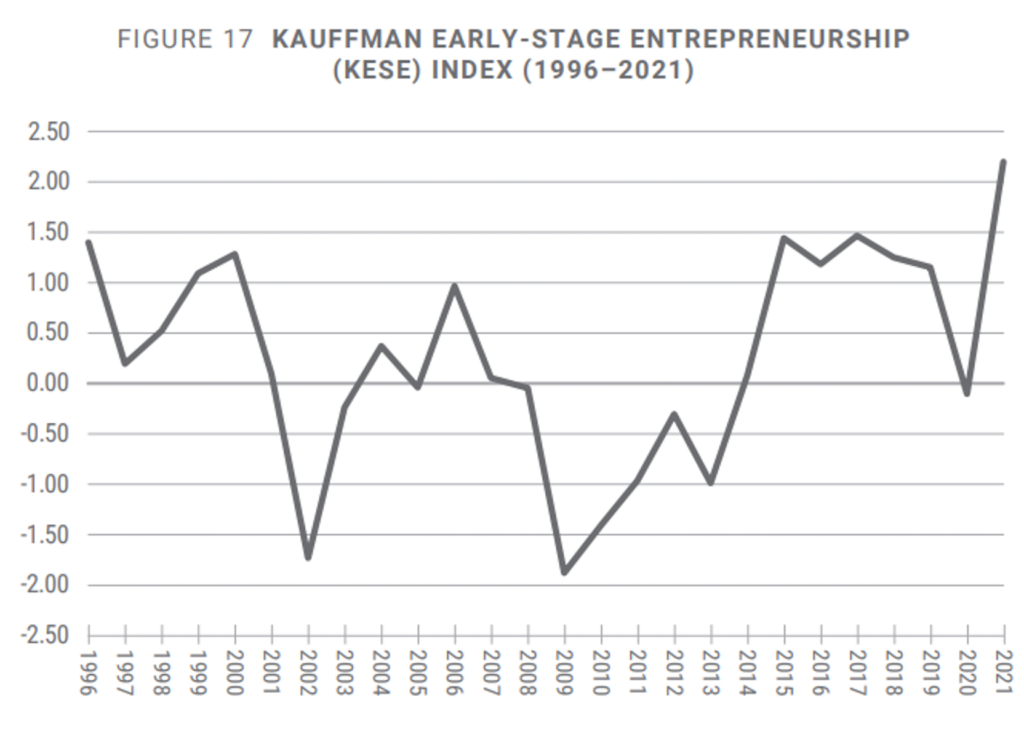

For more than 25 years the Kauffman Foundation has published important research on U.S. entrepreneurship, including the dynamics around new business creation. The founder, Ewing Marion Kauffman — an entrepreneur himself — understood that entrepreneurship was one of the most effective ways to promote opportunity and economic growth.
Every year the Foundation publishes its KESE Index (Kauffman Early-Stage Entrepreneurship Index), among many other things, which combines four key entrepreneurship metrics:
- Rate of New Entrepreneurs: Captures the percentage of the adult, non-business owner population that starts a business each month.
- Opportunity Share of New Entrepreneurs: Distinguishes between individuals who are “opportunity entrepreneurs” — including those coming out of work, school, or another labor market status — and individuals who are “necessity entrepreneurs” due to unemployment.
- Startup Early Job Creation: Measures annually the number of total jobs that are created by startups in their first year.
- Startup Early Survival Rate: Measures the percentage of new employer establishments that are still active after one year of operation.
The KESE index is normalized at zero which represents the average for the past two decades. A positive index value indicates that the index is above this two-decade average while a negative value indicates that it is below this average. During the past few years, the index has been about 1.2, some of its highest levels, reflecting the strong economic conditions prior to the pandemic. The lowest level was -1.9 in 2009 during the Great Recession.
We’ll share some of the 2021 KESE Index insights momentarily, but here are a few contextual observations from entrepreneurship research historically:
As a baseline, since 1996 the rate of new entrepreneurs — the non-business owner population that starts a business each month — has consistently hovered around 0.30 percent or 300 per 100,000 adults. (A noteworthy aside is that this rate among immigrants has always been higher than U.S. born citizens.)
Also, we have known for a long time that startup companies create more new jobs — almost every year — than well-established companies. That’s why keeping track of startup activity is so important. For the past decade, startups have created an average of five new jobs in their first year.
The failure rate of startups is also highly publicized, which is a reality check for how difficult it is to sustain a new business over time. Kauffman focuses on early (first year) survival rates, which have been in the 75-80 percent range for the last 25 years. You will also hear about the percent of companies that fail within five and 10 years, which hovers around 50 percent and 70 percent respectively, depending on the source.
Did you start your company out of necessity or opportunity?

In March, Jessica Looze and Robert Fairlie published, Are We Back? Early-Stage Entrepreneurship Trends Two Years into the COVID Pandemic. In it, they reported that during the COVID-19 Pandemic the U.S. saw the highest rate of new entrepreneurs on record. This rate had been hovering around 0.31 percent for several years. In 2020, it rose to 0.38 percent – meaning that on average, roughly 3.8 out of every 1,000 adults in the U.S. became new entrepreneurs. In 2021, while the rate of new entrepreneurs declined slightly, it was still higher than pre-pandemic rates at 0.36 percent.
During turbulent times like the pandemic, the rate of new entrepreneurs can increase substantially as businesses close and restart, and workers are laid off and turn to part-time business activities. The Great Recession saw a similar, though less pronounced, increase in new entrepreneurship.

However, the 2020 rise in entrepreneurs was not indicative of greater opportunity. In fact, we saw the lowest opportunity share of new entrepreneurs on record. Again, opportunity share refers to business activity that was inspired by opportunity rather than necessity. The opportunity share saw a 17.1 percent drop between 2019 and 2020 – from 86.9 percent to 69.8 percent. In other words, about 30 percent of new entrepreneurs were unemployed at the time they started their business in 2020. There was a similar but smaller effect in opportunity share during the Great Recession as well.
This was one of the main causes of a large drop in the KESE Index in 2020, which went to -0.1 from 1.2 in 2019.

In 2021, the opportunity share increased to 80.9 percent, so only about 19 percent of new entrepreneurs were unemployed at the time of starting their business. While this rebound is substantial, the opportunity share of new entrepreneurs is still not back to its pre-pandemic level of 86.9 percent. However, combined with the other KESE metrics, the index jumped to 2.2 in 2021.
This is great news because entrepreneurs are our economic future. We need to support and encourage our entrepreneurs and do everything we can to help them succeed, in good times and bad. To those who started new ventures out of necessity during the pandemic, we hope your businesses and lives are thriving as conditions have improved. And to those entrepreneurs of opportunity who held off on taking the leap due to the pandemic, your time to launch may have arrived. Opportunity-oriented ventures are typically the highest-growth enterprises, and we need those economic contributions to the region.